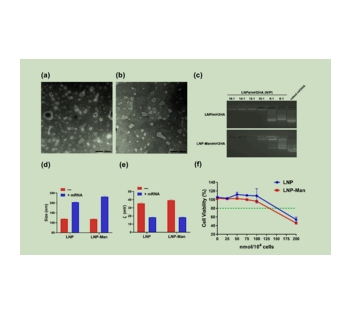文献:mRNA Vaccines Encoding the HA Protein of Influenza A H1N1 Virus Delivered by Cationic Lipid Nanoparticles Induce Protective Immune Responses in Mice
文献链接:https://pubmed.ncbi.nlm.nih.gov/32164372/
作者:Xinyu Zhuang , Yanxin Qi , Maopeng Wang , Ning Yu , Fulong Nan , He Zhang , Mingyao Tian , Chang Li , Huijun Lu, Ningyi Jin
相关产品:DSPE-PEG-Mannose 磷脂-聚乙二醇-甘露糖
原文摘要:The design of the mRNA vaccine involves the selection of in vitro transcription (IVT)
systems and nonviral delivery vectors. This study aimed to verify the effect of 5’ and 3’ untranslated region (UTR) sequences on the translation efficiency of mRNA. Three modes of IVT-mRNA systems (IVT-mRNA-n1/n2/n3) with diverse UTRs were constructed, and EGFP (enhanced green fluorescent protein) and HA (hemagglutinin) gene of H3N2 influenza virus were introduced into each of them.The results showed that the mode of 5’ and 3’ UTRs originating from human β-globulin was better than the mode of UTRs from human α-globulin, and the n3 mode was the best. mEGFP-n3, mH3HA-n3, and mLuciferease-n3 were prepared to compare the effect of cationic lipid nanoparticle (LNP) with that of mannose-conjugated LNP (LNP-Man) on the efficiency of gene delivery. The results showed that the effect of LNP-Man was better than that of LNP both in vitro and in vivo. Choosing appropriate ligands might help in vaccine design. After selecting the IVT-mRNA-n3 system and delivery vectors, mRNA vaccines were constructed against the H1N1 influenza virus, and C57BL/6 mice were immunized through intranasal administration. The results showed that mRNA vaccines could elicit both humoral and cellular immune responses and completely protect mice from the tenfold LD50 H1N1 influenza virus challenge.
甘露糖(Mannose)是一种单糖,属于己糖,其分子式为 C₆H₁₂O₆。它的化学结构是一个六元环(吡喃糖),在溶液中存在 α-型和 β-型两种异构体,二者的区别在于环上羟基的位置不同。α-甘露糖的 1 号碳上的羟基与 2 号碳上的羟基处于环平面的同侧,而 β-甘露糖则处于异侧。纳米颗粒作为非virus传递系统,纳米颗粒为体内中外源性mRNA的表达提供了多种平台。阳离子脂质纳米颗粒由于其良好的生物相容性成为mRNA传递系统之一。阳离子脂质/mRNA纳米颗粒可以保护mRNA不被核酸酶降解,并通过静电吸附和与细胞膜融合将其传递到细胞中。配备配体的亲脂性分子可以特异性识别细胞上的受体,提高传递效率。

图为:三种体外转录系统模式的模式图
构建了三种体外转录mRNA系统模式(IVT-mRNA-n1/n2/n3)。通过体外实验比较不同模式下的外源基因表达效率,并选择mRNA翻译效率最高的IVT-mRNA-n3进行后续实验。制备阳离子脂质纳米颗粒(LNPs)和甘露糖偶联LNP(LNP- Man)包裹mRNA。LNP-Man在体内外的效果均优于LNP,分别用两种LNPs封装。
LNPs/mRNA的配方:LNP包括1、2-二油基-3-三甲基铵-丙烷(DOTAP)、1、2-二油基-sn-甘油-3-磷酸乙醇胺(DOPE)和1、2-distearoyl-sn-glycero-3-phosphoethanolamine-N-(甲氧基(聚乙二醇)-2000)(DSPE-mPEG2000)。LNP-Man含有DOTAP、DOPE和DSPE-PEG-Mannose 。两者均采用薄膜水化法制备。简单地说,所有的材料都以指定的摩尔比溶解在氯仿中,然后使用旋转蒸发器蒸发。将得到的干膜用 HEPES缓冲液水合,并在水浴超声速装置中分散。最后,通过无菌过滤器过滤溶液。使用莫尔文泽塔西泽纳米ZS90测量了尺寸和zeta电位。
将LNPs/mRNA按N:P摩尔比,并在室温下温和涡旋孵育,计算DOTAP与RNA的摩尔比,采用凝胶法研究LNPs/mRNA的包装效率。N/Ps/mRNA配合物分别制备LNPs/mRNA配合物。然后,将样品与6×装载缓冲液混合装于琼脂糖凝胶上运行,使用成像仪获取图片。

图为:脂质纳米颗粒(LNPs)和LNPs/mRNA的表征
人β-球蛋白的5‘和3’的序列和排列模式也影响了mRNA的翻译效率。配备甘露糖配体的LNP在体内和体外都有更好的基因传递效率。该LNPs/mRNA平台可用于mRNA的构建。

 2025-02-12 作者:lkr 来源:
2025-02-12 作者:lkr 来源:

